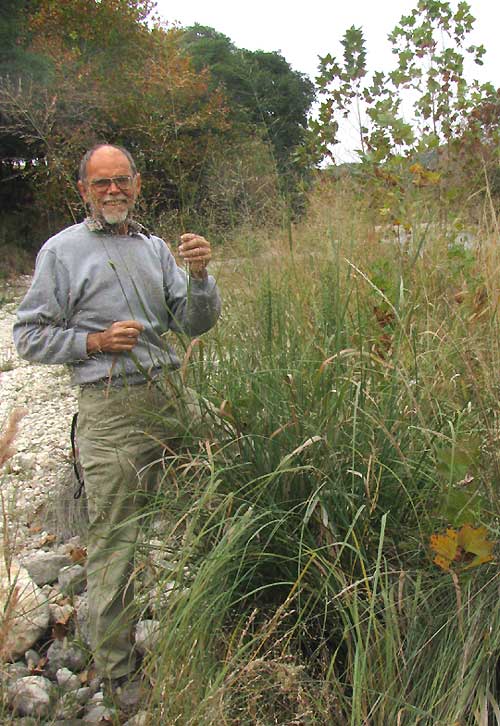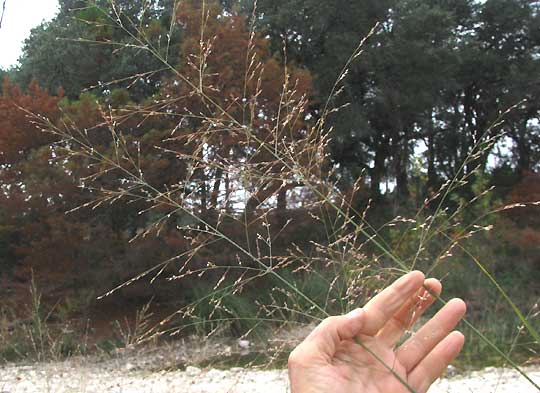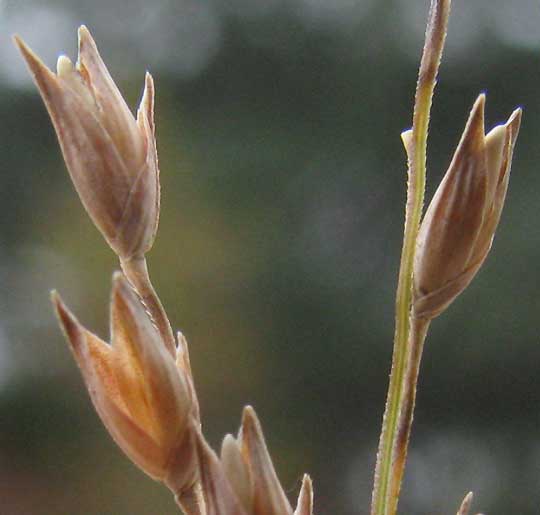Excerpts from Jim Conrad's
Naturalist Newsletter
from the November 25, 2012 Newsletter issued from the valley of the Dry Frio River in northern Uvalde County, southwestern Texas, on the southern border of the Edwards Plateau; elevation ~1750m (~5750 ft); N29.62°, W99.86°; USA
SWITCHGRASS
In earlier Newsletters featuring our local grasses we've referred to the convention that often when referring to the grass species constituting central North America's vast prairie region, we speak of the "Big Four" species -- Big and Little Bluestems, Indiangrass and Switchgrass. In the valley of the little Dry Frio River Little and Big Bluestems are abundant. The other two species are present, but not nearly so common.
Switchgrass, PANICUM VIRGATUM, is a perennial clumpgrass like the other "Big Four." It grows commonly along the moist banks of the Dry Frio, and on fields of cobblestones in the river's floodplain not high above the river's level, but I don't find it in drier environments elsewhere. Along the river it's a tall grass, its flowering heads rising well over seven feet (2.1m), as shown below:

Switchgrass's flowering heads, or inflorescences, are large and disperse panicles with small spikelets at branch tips, as shown below:

The spikelets are only about 3/16ths inch long (4.5mm) and each spikelet produces only one grain. Three spikelets are shown below:

One final field mark is that the ligule -- the eyebrow-like growth where the blade base meets the stem -- consists of a dense tuft of hairs, as shown below:

Some grasses have cellophane-like ligules, others have lobed or pointed ones, some grasses have none at all.
Switchgrass occurs naturally from Canada through the US, deep into Mexico. If you've been paying attention to news in the field of alternative energy sources, you've heard a lot about Switchgrass, because it's been singled out for its potential as a very significant source of bioenergy. It produces a lot of stems and leaves relatively quickly, without needing much fertilizer or pesticides, and those stems and leaves can be fermented to produce ethanol. Switchgrass stems and leaves also can be formed into hard pellets which can be burned directly in stoves, instead of coal or wood. Under the heading "Bioenergy," the Wikipedia Switchgrass page does a good job summing up the present state of using Switchgrass as bioenergy at https://en.wikipedia.org/wiki/Panicum_virgatum.
Switchgrass has its own website at http://www.switchgrass.nl/.
One problem with using Switchgrass for bioenergy production is precisely the fact that it's a crop that can be grown on what's usually called "marginal land." "Marginal land" is land usually not yet taken over by agricultural monocultures such as cornfields and wheatfields. Monocultures are ecological deserts, are murderous to wildlife, and represent the opposite of biodiversity.
But already the world has focused enough on Switchgrass's potentials for several cultivars to have been created, which produce more energy with less fertilizer than the wild stock. In the US, Switchgrass genes have been modified so that plants produce polyhydroxybutyrate, which is a polymer belonging to the polyester class. Polyhydroxybutyrate accumulates in beadlike granules within the plant's cells. One use for it might be the making of polyester-type clothing.